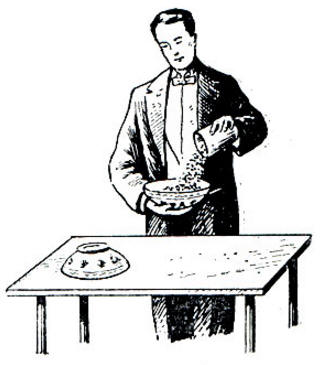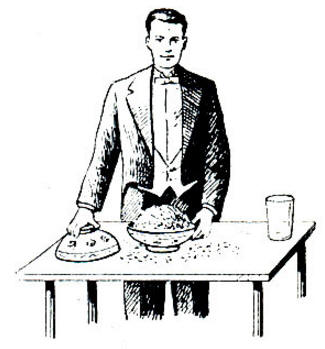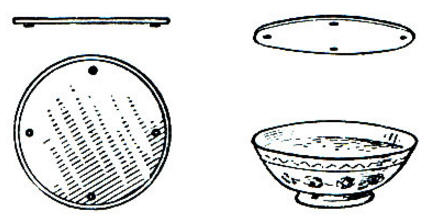
|
|
EFFECTIVE FOCUSES AND THEIR CLUES Rice vases. Focus secret
Directory / Spectacular tricks and their clues Focus Description: They bring out a small table on which stand, turned upside down, two bowls. There is also a large glass filled with rice (Fig. 241).
The magician, approaching the table, lifts one bowl after another and, showing them to the audience, puts them back on the table upside down. Then he takes the left bowl and says that he really loves pilaf and wants to cook it. For this you need rice. Here it is in a glass, but this rice is not enough. “It doesn’t matter,” says the magician, “I have “magic” bowls that will help me with this.” The artist takes a glass of rice and pours the rice into the left bowl, which he holds in his right hand (Fig. 242).
Then he puts the glass on the table. Having shown the audience that there is not enough rice in the bowl, he takes the second bowl with his right hand and covers the rice in the first bowl with it (Fig. 243).
The magician remembers that he needs to cast some spells, but he does not know them and does not believe in their power. As he says this, he hesitantly turns the bowls in his hands several times, then places them on the table, covering one with the other. The artist quickly removes the top bowl with his right hand and places it to the right, having previously shown that it is empty and there is nothing in it. Spectators see that the lower bowl is so full of rice that it even spills over the edge (Fig. 244).
The magician says that this rice is now quite enough, and again covers it with his right bowl. He again turns the bowls several times in his hands, then places them on the table and, having removed the top bowl, places it upside down on the table. The second bowl turns out to be full of water. The artist pours water from a bowl into a glass and back (Fig. 245). “Well,” says the magician, “after all, water is also necessary for pilaf!”
Props: A large glass full of rice. Two bowls, one of which has a secret device. Focus secret: You probably know the physical experiment of filling a glass to the brim with water, then covering the opening of the glass with paper, making sure that there is no air between the water and the paper. Excess air is removed by pressing on the paper. If you now turn the glass upside down, the water will not pour out of it, since air from outside will press on the paper. The trick with bowls is based on this principle, only the role of paper is played by a transparent celluloid or plexiglass thin circle. In order for it to stick better to the bowl, you need to sand the edges of the bowl with sandpaper. To do this, spread a sheet of sandpaper on the table and, placing the bowl on it with the upper edge, grind it, or rather, grind down the edges of the bowl so that they are smooth and wide enough; then the celluloid will stick to them well. Do this with both bowls. Then they make a device for one of the bowls. This device is nothing more than a circle cut out of transparent celluloid with a diameter exactly the size of the bowls. In order not to be mistaken in the size of the circle, place the bowl on the celluloid and outline the edges of the bowl with a needle, and then accurately cut out the circle. To make the circle stick better to the bowl, stick small pieces of celluloid on it - they will prevent the celluloid from sliding to the side. It is better to make the edge of the circle rough, for which you need to rub sandpaper along it several times (Fig. 246). It is best to take celluloid 2 mm thick, but thinner ones can be used. For this trick, it is better to have plexiglass, as it is more transparent than celluloid.
Preparation and demonstration of the trick. In order to “charge” the bowl with water, immerse it in a bowl of water and place a circle there. Then cover the bowl with a circle in the water and press the circle onto the bowl. Now carefully remove the bowl from the water, wipe it dry and place it in a circle down on the table. The bowl is “charged”. To prevent the circle from sticking to the table board, place a match under it on the table, then the circle will not lie with its entire plane on the table and it can be easily lifted along with the bowl. When overturning a bowl of water, you should be careful; you need to hold the edges of the circle a little with your fingers. When charging the bowl, make sure that there is not a single air bubble under the celluloid circle, otherwise the bowl may “discharge” and water will immediately rush out of it. Place a charged bowl of water on the table on the right, and place a second empty bowl on the left next to it. Place a glass of rice on the very edge of the table on the left. The focus preparation is complete. Now a few words about the demonstration. When showing both bowls empty, you should show the left (empty) bowl first; you can fix the audience’s attention on it longer. Then with your right hand, lift the right (“charged”) bowl and carefully turn it towards the audience, but keep in mind that the celluloid can reflect the light of the lamps if they are located opposite. It is best, without looking at the bowl, to lift it and pretend that you are moving your hand inside the bowl, and then immediately put the bowl upside down again on the match. Then you pour rice into the left bowl, carefully cover it with the right bowl (with water), lift both bowls together and, turning them several times, place them on the table so that the bowl with water is at the bottom and the bowl with rice is at the top. If you now remove the upper bowl, the rice, scattered on the celluloid, will give the impression that the lower bowl is full of rice and it is even pouring out of it. Then, taking an empty bowl, you cover the bowl of water with it and again begin to turn the bowls over, and then place them on the table so that the bowl of water is at the bottom. Now wrap your fingers around the edges of the upper bowl, grabbing the celluloid circle with them, quickly remove it from the lower bowl and place the bowl carefully on the table with the bottom up. Now the water in the bowl is open and you can pour it into the glass and back into the bowl. The trick is over. In conclusion, we advise: to make it easier to remove the celluloid circle from the bowl, move it slightly to the side and try to slip the nail of the middle finger of your right hand under it - the circle will immediately fall away from the edge of the bowl. Author: Vadimov A.A.
Machine for thinning flowers in gardens
02.05.2024 Advanced Infrared Microscope
02.05.2024 Air trap for insects
01.05.2024
▪ First 200V DirectFET Transistor from IR ▪ Thermonuclear fusion with a magnetized target
▪ site section Electric motors. Article selection ▪ article by JK Rowling. Famous aphorisms ▪ article Why tights got such a name by mistake? Detailed answer ▪ article Valerian pharmacy. Legends, cultivation, methods of application ▪ article Quartz oscillators. Encyclopedia of radio electronics and electrical engineering
Home page | Library | Articles | Website map | Site Reviews www.diagram.com.ua |






 Arabic
Arabic Bengali
Bengali Chinese
Chinese English
English French
French German
German Hebrew
Hebrew Hindi
Hindi Italian
Italian Japanese
Japanese Korean
Korean Malay
Malay Polish
Polish Portuguese
Portuguese Spanish
Spanish Turkish
Turkish Ukrainian
Ukrainian Vietnamese
Vietnamese







 See other articles Section
See other articles Section 